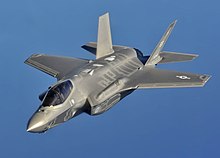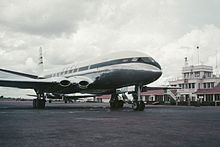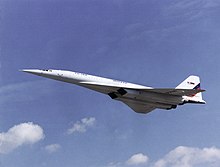Jet aircraft


A jet aircraft (or simply jet) is an aircraft (nearly always a fixed-wing aircraft) propelled by jet engines.
Whereas the engines in propeller-powered aircraft generally achieve their maximum efficiency at much lower speeds and altitudes, jet engines and aircraft achieve maximum efficiency at speeds close to or even well above the speed of sound. Jet aircraft generally cruise at faster than about Mach 0.8 (609 mph, 981 km/h or 273 m/s) at altitudes around 10,000–15,000 metres (33,000–49,000 ft) or more.
Frank Whittle, an English inventor and RAF officer, developed the concept of the jet engine in 1928,[1] and Hans von Ohain in Germany developed the concept independently in the early 1930s. He wrote in February 1936 to Ernst Heinkel, who led the construction of the world's first turbojet aircraft and jet plane Heinkel He 178.
History


After the first instance of powered flight, a large number of jet engine factories were suggested. René Lorin, Morize, Harris proposed systems for creating a jet efflux.[2] In 1910 the Romanian inventor Henri Coandă filed a patent on a jet propulsion system which used piston-engine exhaust gases to add heat to an otherwise pure air stream compressed by rotating fan blades in a duct. It was installed in his Coandă-1910 but this craft probably never flew.
Rocket-powered jet aircraft were pioneered in Germany. The first aircraft to fly under rocket power was the Lippisch Ente, in 1928.[3] The Ente had previously been flown as a glider. The next year, in 1929, the Opel RAK.1 became the first purpose-built rocket plane to fly.
The turbojet was invented in 1939, independently by Frank Whittle and later Hans von Ohain. The first turbojet aircraft to fly was the Heinkel He 178 V1 first prototype of the German Air Force, the Luftwaffe, on August 27, 1939 in Rostock (Germany).[4]
The first flight of a jet-engined aircraft to come to public attention was the Italian Caproni Campini N.1 motorjet prototype that flew on August 27, 1940.[5] It was the first jet aircraft recognised by the Fédération Aéronautique Internationale (at the time the German He 178 program was still kept secret). Campini had proposed the motorjet in 1932.
The British experimental Gloster E.28/39 first took to the air on May 15, 1941, powered by Sir Frank Whittle's turbojet.[6] The United States produced the Bell XP-59A using two examples of a version of the Whittle engine built by General Electric, which flew on October 1, 1942. The Meteor was the first production jet as it entered production a few months before the Me 262,[citation needed] which itself had been in development since before the start of the war as Projekt 1065.

The first operational jet fighter was the Messerschmitt Me 262,[7] manufactured by Germany during World War II, which entered service on 19 April 1944 with Erprobungskommando 262 at Lechfeld just south of Augsburg. It was the fastest conventional aircraft of World War II – although there were faster aircraft propelled by unconventional means, such as the rocket-powered Messerschmitt Me 163 Komet. The Messerschmitt Me 262 had first flown on April 18, 1941, with initial plans drawn up by Dr Waldemar Voigt's design team in April 1939, but mass production did not start until early 1944 with the first squadrons operational that year, too late for a decisive effect on the outcome of the war.

Around this time, mid 1944, the United Kingdom's Gloster Meteor was being committed to defence of the UK against the V-1 flying bomb – itself a pulsejet-powered aircraft and direct ancestor of the cruise missile– and then ground-attack operations over Europe in the last months of the war. In 1944 Germany introduced into service the Arado Ar 234 jet reconnaissance and bomber, though chiefly used in the former role, with the Heinkel He 162 Spatz single-jet light fighter premiering as 1944 ended. USSR tested its own Bereznyak-Isayev BI-1 in 1942, but the project was scrapped by Joseph Stalin in 1945. The Imperial Japanese Navy also developed jet aircraft in 1945, including the Nakajima J9Y Kikka, a modified, and slightly smaller version of the Me 262 that had folding wings. By the end of 1945, the US had introduced their first jet fighter, the Lockheed P-80 Shooting Star into service and the UK its second fighter design, the de Havilland Vampire.

The US introduced the North American B-45 Tornado, their first jet bomber, into service in 1948. Although capable of carrying nuclear weapons it was used for reconnaissance over Korea. On November 8, 1950, during the Korean War, United States Air Force Lt. Russell J. Brown, flying in an F-80, intercepted two North Korean MiG-15s near the Yalu River and shot them down in the first jet-to-jet dogfight in history. The UK put the English Electric Canberra into service in 1951 as a light bomber. It was designed to fly higher and faster than any interceptor.


BOAC operated the first commercial jet service, from London to Johannesburg, in 1952 with the de Havilland Comet jetliner. This highly innovative aircraft travelled far faster and higher than the propeller aircraft, was much quieter, smoother, and had stylish blended wings containing hidden jet engines. However, due to a design defect, and use of aluminium alloys, the aircraft suffered catastrophic metal fatigue which led to several crashes.[8]
The series of crashes gave time for the Boeing 707 to enter service in 1958 and this came to dominate the market for civilian airliners. The underslung engines were found to be advantageous in the event of a propellant leak, and so the 707 looked rather different from the Comet: the 707 has a shape that is effectively the same as that of contemporary aircraft, with marked commonality still evident today for example with the 737 (fuselage) and A340 (single deck, swept wing, four below-wing engines).
Turbofan aircraft began entering service in the 1950s and 1960s, bringing far greater fuel efficiency, and this is the type of jet in widespread use today.

The Tu-144 supersonic transport was the fastest commercial jet plane at Mach 2.35 (1,555 mph, 2,503 km/h). It went into service in 1975, but soon stopped flying. The Mach 2 Concorde aircraft entered service in 1976 and flew for 27 years.
The fastest military jet plane was the SR-71 Blackbird at Mach 3.35 (2,275 mph, 3,661 km/h).
Other jets
Most people use the term 'jet aircraft' to denote gas turbine based airbreathing jet engines, but rockets and scramjets are both also propelled by jet propulsion.
Cruise missiles are single-use unmanned jet aircraft, powered predominately by ramjets or turbojets or sometimes turbofans, but they will often have a rocket propulsion system for initial propulsion.
The fastest airbreathing jet aircraft is the unmanned X-43 scramjet at around Mach 9–10.
The fastest manned (rocket) aircraft is the X-15 at Mach 6.85.
The Space Shuttle, while far faster than the X-43 or X-15, was not regarded as an aircraft during ascent as it was carried ballistically by rocket thrust, rather than the air. During re-entry it was classed (like a glider) as an unpowered aircraft. The first flight was in 1981.
The Bell 533 (1964), Lockheed XH-51 (1965), and Sikorsky S-69 (1977-1981) are examples of compound helicopter designs where jet exhaust added to forward thrust.[9] The Hiller YH-32 Hornet and Fairey Ultra-light Helicopter were among the many helicopters where the rotors were driven by tip jets.
Jet-powered wingsuits exist - powered by model aircraft jet engines - but of short duration and needing to be launched at height.[10]
Aerodynamics

Because of the way they work, the typical exhaust speed of jet engines is transonic or faster, therefore most jet aircraft need to fly at high speeds, either supersonic or speeds just below the speed of sound ("transonic") so as to achieve efficient flight. Aerodynamics is therefore an important consideration.
Jet aircraft are usually designed using the Whitcomb area rule, which says that the total area of cross-section of the aircraft at any point along the aircraft from the nose must be approximately the same as that of a Sears-Haack body. A shape with that property minimises the production of shockwaves which would waste energy.
Jet engines
Jet engines come in several main types:
- turbojet
- turbofan (which come in two main forms low bypass turbofan and high bypass turbofan)
- rocket
The different types are used for different purposes.
Rockets are the oldest type and are mainly used when extremely high speeds or extremely high altitudes are needed. Due to the extreme, typically hypersonic, exhaust velocity and the necessity of oxidiser being carried on board, they consume propellant extremely quickly. For this reason, they are not practical for routine transportation.
Turbojets are the second oldest type; it has a high, usually supersonic, exhaust speed and low frontal cross-section, and so is best suited to high-speed, usually supersonic, flight. Although once widely used, they are relatively inefficient compared to turboprop and turbofans for subsonic flight. The last major aircraft to use turbojets were Concorde and Tu-144 supersonic transports.
Low bypass turbofans have a lower exhaust speed than turbojets and are mostly used for high sonic, transonic, and low supersonic speeds. High bypass turbofans are used for subsonic aircraft and are quite efficient and are widely used for airliners.
Flying characteristics
Jet aircraft fly considerably differently to propeller aircraft.
One difference is that jet engines respond relatively slowly. This complicates takeoff and landing maneuvers. In particular, during takeoff, propeller aircraft engines blow air over their wings and that gives more lift and a shorter takeoff. These differences caught out some early BOAC Comet pilots.[8]
Propulsive efficiency
In aircraft overall propulsive efficiency is the efficiency, in percent, with which the energy contained in a vehicle's propellant is converted into useful energy, to replace losses due to air drag, gravity, and acceleration. It can also be stated as the proportion of the mechanical energy actually used to propel the aircraft. It is always less than 100% because of kinetic energy loss to the exhaust, and less-than-ideal efficiency of the propulsive mechanism, whether a propeller, a jet exhaust, or a fan. In addition, propulsive efficiency is greatly dependent on air density and airspeed.
Mathematically, it is represented as [11] where is the cycle efficiency and is the propulsive efficiency. The cycle efficiency, in percent, is the proportion of energy that can be derived from the energy source that is converted to mechanical energy by the engine.

For jet aircraft the propulsive efficiency (essentially energy efficiency) is highest when the engine emits an exhaust jet at a speed that is the same as, or nearly the same as, the vehicle velocity. The exact formula for air-breathing engines as given in the literature,[12][13] is
where c is the exhaust speed, and v is the speed of the aircraft.
Range
For a long range jet operating in the stratosphere, the speed of sound is constant, hence flying at fixed angle of attack and constant Mach number causes the aircraft to climb, without changing the value of the local speed of sound. In this case:
where is the cruise Mach number and the local speed of sound. The range equation can be shown to be:
which is known as the Breguet range equation after the French aviation pioneer Louis Charles Breguet.
See also
- Coandă-1910
- Commercial aviation
- Contrail
- Jet airliner
- Jet noise
- Jumbo jet
- Very light jet
- List of jet aircraft of World War II
References
Citations
- ^ CWN, Chris Studman for. "Sir Frank Whittle - Jet Engine Inventor - Born In Coventry". www.cwn.org.uk. Archived from the original on 20 October 2017. Retrieved 6 May 2018.
- ^ Jet Propulsion of Aircraft Part III Archived 2012-11-05 at the Wayback Machine G Geoffrey Smith Flight September 25th 1941
- ^ "Lippisch Ente."[permanent dead link] The Internet Encyclopedia of Science: Experimental Aircraft. Retrieved: 26 September 2011.
- ^ Warsitz, Lutz: The First Jet Pilot – The Story of German Test Pilot Erich Warsitz (p. 125), Pen and Sword Books Ltd., England, 2009 Archived 2010-06-03 at the Wayback Machine
- ^ "Flight 28 August 1941". flightglobal.com. Archived from the original on 20 October 2017. Retrieved 6 May 2018.
- ^ "No Airscrew Necessary..." Archived 2012-10-25 at the Wayback Machine Flight(flightglobal.com), 27 October 1949 p554
- ^ Hecht, Heinrich. The World's First Turbojet Fighter – Messerschmitt Me 262. Atglen, Pennsylvania: Schiffer Publishing, 1990. ISBN 0-88740-234-8.[page needed]
- ^ a b Jet! When Britain Ruled the Skies - BBC
- ^ "The Fastest Helicopter on Earth". IEEE Spectrum. 31 Aug 2010. Archived from the original on 30 January 2017. Retrieved 1 August 2017.
{{cite web}}: Unknown parameter|authors=ignored (help) - ^ "'Jetman' Yves Rossy Shows Us How to Fly His Carbon Fiber Jet Wing". Wired. 31 July 2013. Archived from the original on 2 January 2017. Retrieved 1 August 2017.
- ^ ch10-3 Archived 2010-09-14 at the Wayback Machine
- ^ K.Honicke, R.Lindner, P.Anders, M.Krahl, H.Hadrich, K.Rohricht. Beschreibung der Konstruktion der Triebwerksanlagen. Interflug, Berlin, 1968
- ^ Spittle, Peter. "Gas turbine technology" Archived 2014-10-31 at the Wayback Machine p507, Rolls-Royce plc, 2003. Retrieved: 21 July 2012.
Bibliography
- Lutz Warsitz: The First Jet Pilot – The Story of German Test Pilot Erich Warsitz, Pen and Sword Books Ltd., England, 2009, ISBN 978-1-84415-818-8, English Edition









